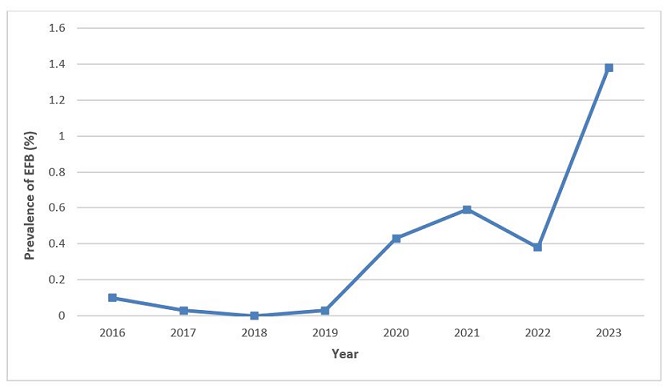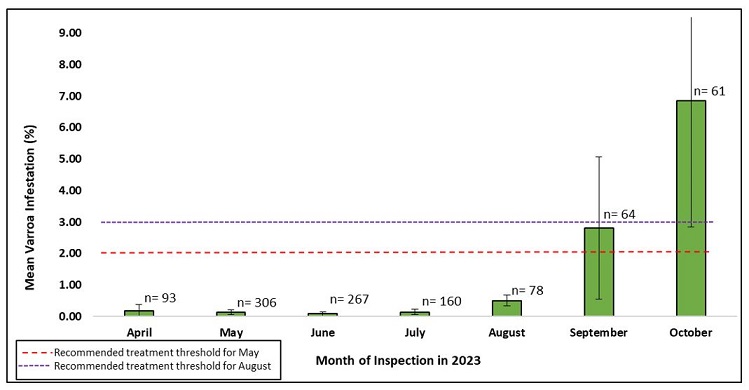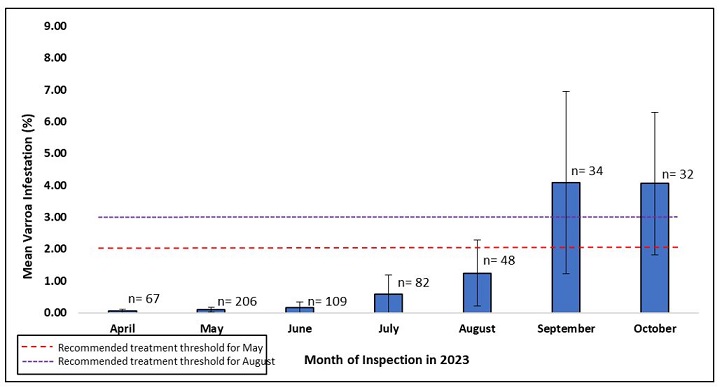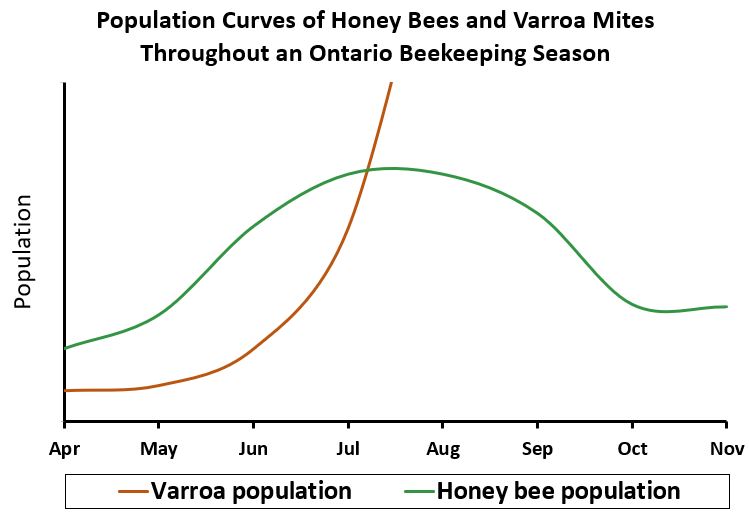2023 Provincial Apiarist report
2023 Season highlights
The Ministry of Agriculture, Food and Rural Affairs’ (OMAFRA) Apiary Program conducted regular and targeted inspections in 2023.
Approximately 18,564 honey bee colonies were shipped outside of Ontario for the pollination of blueberry and cranberry crops in eastern Canada.
Ontario beekeepers reported an overall overwinter honey bee mortality of 36% for the winter of 2022-2023. This was lower than the overwinter mortality reported in the previous year (49%).
Notable statistics about the 2023 Ontario beekeeping industry include:
- number of registered beekeepers: 3,980
- number of registered colonies: 101,161
- average honey yield/colony: 32 kg (70 lb) per colony
- total estimated honey crop: 3.2 million kg (7.1 million lb)
- overwinter honey bee losses reported by commercial beekeepers: 36%
- selling permits issued: 146
- queen and nuc permits issued: 89 (there were an additional 115 beekeepers with valid queen and nuc permits from the year before with a total of 204 beekeepers holding valid queen and nuc permits for the 2023 season)
- import permits issued: 19
Pest and disease levels
During the 2023 beekeeping season, OMAFRA inspected a total of 625 bee yards. The presence of common apiary pests and diseases was assessed by ministry apiary inspectors through the brood nest inspection of 10,451 colonies. Inspectors checked for varroa mites in 1,614 of the colonies receiving brood nest inspections and checked for small hive beetle in an additional 5,348 colonies through top bar inspections. The prevalence of the following diseases among inspected colonies were:
- American foulbrood: 0.34%
- European foulbrood: 1.38%
- sacbrood virus: 0.02%
The data represents the colonies inspected in 2023 and is not necessarily reflective of the beekeeping industry across the province.
American foulbrood (Paenibacillus larvae)
American foulbrood (AFB), a bacterial disease of honey bees, was detected in 35 honey bee colonies or 0.34% of the colonies inspected in Ontario. These colonies represented 11 bee yards positive for AFB or 1.79% of the yards inspected. The 2023 data represents a decrease in AFB from 2022 when AFB was observed in 0.56% of colonies.
Sample analysis continues to confirm that the strains of AFB circulating in Ontario remain susceptible to oxytetracycline.
European foulbrood (Melissococcus plutonius)
European foulbrood (EFB), a bacterial disease of honey bees, was detected in 144 honey bee colonies or 1.38% of the colonies inspected in Ontario. These colonies represented 39 bee yards positive for EFB or 5.83% of the yards inspected. The 2023 data represents a major increase in EFB from 2022 when EFB was observed in 0.38% of colonies. There appears to be a sustained trend of increase in EFB over recent years in Ontario (Figure 1). This trend has also been observed and reported from other apiary programs in North America. In addition, the more recent cases of EFB have been reported to be more difficult to treat and manage. In some provinces, colonies with serious EFB infections have been reported to be incapable of recovering. The possible underlying reasons for this situation are outside the scope of this report and are areas that researchers are investigating further.

Small hive beetle (Aethina tumida)
Small hive beetle (SHB) is an insect pest of honey bees. A total of 4 new apiaries, including both commercial (operating 50 or more colonies) and small-scale operations (operating 49 or fewer colonies), tested positive for SHB in Ontario. This represents a decrease in new detections in 2023 when compared to 2022 (n=10). Differences in detections of SHB in beekeeping operations may be due to variation in weather patterns, colony conditions or beekeeper management practices. As well, the positive findings of SHB may also be overrepresented in inspection results due to the high rate of inspection of colonies in the Niagara region to allow for the movement of colonies for out of province pollination. Colonies in the Niagara region make up a large proportion of apiary inspections.
The presence of SHB larvae, which is the main cause of SHB damage to colonies, is documented during apiary inspections. Reports continue to demonstrate that there have been very few instances of SHB creating damage to colonies in the province and the impact of this pest in Ontario remains limited to date.
The ministry has an online map showing the number of SHB-positive bee yards confirmed in each township. This map not only provides current data to other jurisdictions that import Ontario honey bees, but also informs beekeepers about where SHB has been detected in Ontario, which helps them to manage the risk to their beekeeping activities.
Varroa mites (Varroa destructor)
Ministry apiary inspectors sample for varroa mites, a common and very serious pest of honey bees, during regular apiary inspections. Varroa mites were typically documented at low levels of infestation early in the beekeeping season for both commercial and small-scale beekeepers, but increased to high levels later in the season. Across the province, 1,614 (1,029 commercial, 585 small-scale) colonies were inspected for varroa mites using a standard alcohol wash (a sample of approximately 300 bees collected from the brood nest, washed in alcohol and the varroa mites filtered and quantified).
As varroa mites are widely distributed across the province, the prevalence of these mites is not as informative as the degree of infestation. Guzman et al. (2010) established treatment thresholds for varroa mite infestations. Colonies should be treated for varroa mites in:
- May if the infestation is greater than 2%
- August if the infestation is greater than 3%


Among commercial operations, the mean varroa mite infestation remained below treatment thresholds only in the early part of the season. Mean varroa mite infestations ranged from a low of 0.09% in June to a high of 6.84% in October (Figure 2). The degree of varroa mite infestation among small-scale operations was also lower at the beginning of the season and then higher during the end of the season, peaking similar to commercial beekeepers but with many more instances of high levels of varroa mites found in individual operations as represented by the higher standard error bars. Varroa mite infestations ranged from a low of 0.04% in April to a high of 4.09% in September (Figure 3).
Many colonies sampled (represented by mean) during inspection for varroa mites were found to be above the treatment threshold in late summer and fall (3 varroa mites per 100 bees). This demonstrates that colonies were likely heading into the winter with damaging levels of varroa mite infestation. Uncharacteristically high levels of varroa mites found in the fall may have been a result of the very early warm weather experienced in spring giving both bees and varroa mites the opportunity to increase early in the season. High mite levels are also influenced by how successfully beekeepers sample and manage their varroa mites throughout the season and how successfully they use opportunities to reduce the growth by employing spring and summer treatments, if needed.
The life cycle of varroa mites is linked to and dependent on the life cycle of honey bees as varroa mites cannot reproduce independent of developing honey bees. If reproduction of honey bees takes place earlier in the season, then varroa mites are accordingly increasing their levels earlier and reaching peak populations earlier. As soon as honey bee brood is produced, varroa mites begin to reproduce and increase their population (Figure 4). Additionally, varroa mites have an exponential population growth whereby an increase in levels accelerates with progressive intensity. This is important to note because once varroa mites begin to reach a certain level they may become difficult to manage due to the sheer number present in the colony.

This underscores the importance of regularly monitoring for varroa mite levels throughout the beekeeping season as it can be easy to miss early population peaks, especially when growth falls outside of a typical year’s pattern. Furthermore, if beekeepers do not sample at numerous times throughout the season to know definitively if their varroa mite levels are low, then it becomes very difficult to dismiss varroa mites as a major factor of overwinter colony loss. Ultimately, it is important for beekeepers to understand that weather and seasonal conditions have an influence on varroa mite levels and that they have to adapt their management practices accordingly, especially as earlier springs and warmer weather lasting longer into the fall are becoming more common with climate change.
Overall, the available data demonstrates that both regular monitoring throughout the season and late season monitoring for varroa mites are important. In particular, late season sampling in September and in October, after varroa mite treatment has been applied, is important to ensure that the treatment used was effective at lowering the level of infestation and that reinfestation with varroa mites from nearby apiaries is not occurring.
Learn more about varroa mites.
Treatments for varroa mites
As part of a robust and sustainable integrated pest management strategy for varroa mites (and other pests and diseases) it is important that beekeepers have access to multiple types of treatments with different active ingredients. This allows for rotation of treatments with different active ingredients to delay the onset of pest resistance to such treatments and for use of formulations under different conditions (as timing and weather may vary). The Ontario Beekeepers’ Association is continuing to pursue the registration for 2 new varroa mite treatments. The Canadian Association of Professional Apiculturists, OMAFRA, and the Canadian Honey Council are assisting in different parts of the registration process. The province continues to highlight this as a priority for the health and sustainability of honey bees.
Due to the high levels of varroa mites being found in apiaries in the fall, the Ontario Apiary Program, in conjunction with the Ontario Beekeepers’ Associations’ Technology Transfer Program, sampled for amitraz (active ingredient in the product Apivar®) resistance using a standard Pettis test. Although test results are outside the scope of this report, it is noted that there were no compelling results demonstrating established resistance to amitraz in Ontario.
Honey production
Honey survey questionnaires were conducted using Survey Monkey and were emailed to registered Ontario commercial beekeepers to estimate the average honey production in the province. Responses were received from 19% of surveyed commercial beekeepers, representing approximately 4,700 colonies across the province.
Based on the responses, the estimated average honey production in Ontario was 31.7 kg (69.9 lb) per colony. This is a slight decrease in honey production from 2022 (33.5 kg or 73.9 lb per colony) driven by weather and/or variable nectar-producing conditions in many parts of Ontario, particularly rainfall (for example, too much and too little).
Pollination services
Ontario honey bee colonies are regularly sent to pollinate berry crops in eastern Canada (Quebec, New Brunswick and Prince Edward Island). Approximately 18,564 honey bee colonies were moved from Ontario to eastern Canada in 2023 for the purpose of pollination. This number is down from the 22,000 honey bee colonies that left the province in 2022 for pollination services. This decrease in colony numbers may reflect a short-term decrease in demand in pollination services required from the blueberry sector in eastern Canada as well as the decrease in available colonies managed by Ontario beekeepers (potentially related to winter mortality and pest and disease issues) to provide pollination services, as both may fluctuate from year to year.
As is now set practice, Ontario and the eastern Canadian provinces worked collaboratively to define pre-transportation inspection requirements before colonies were shipped across provincial borders. The spread of small hive beetle from regions in Ontario to eastern Canada remained a concern for inspection requirements in 2023.
Another concern for inspection for pollination colonies in 2023 was EFB as there were 2 large operations in southern Ontario that had difficulty managing serious EFB infections. This greatly impacted the timing of their ability to export their bees for pollination. Pest and disease outbreaks can happen anywhere and at any time. For larger operations expecting to move their bees, there needs to be a high degree of organization, vigilance for pests and diseases (ideally finding pest and disease issues before inspectors visit) and timely management actions by the beekeeper.
Honey bee mortality
Overwinter honey bee mortality
During the spring of 2023, a survey was used to estimate overwinter honey bee colony losses. The survey was distributed to 208 registered commercial beekeepers. Responses were received from 35% of the commercial beekeepers surveyed representing 35,276 colonies across the province. Based on the results of the survey, commercial beekeepers reported an approximate 36% overall honey bee colony loss during the 2022-2023 winter. This was a decrease from the 49% winter loss reported in the previous year (2021-2022). Of note, Ontario’s winter loss was heavily skewed by the significant losses of one large commercial beekeeper. With this beekeepers’ results removed, Ontario’s average winter loss would have been much lower at 17% which would be just above the 15% level of acceptable loss defined by the Canadian Association of Professional Apiculturists. Small-scale beekeepers reported a lower winter loss (26%) than that of the commercial sector.
Refer to the full report on 2023 overwinter losses.
In-season honey bee mortality
A honey bee incident is defined as atypical effects characterized by bee mortality, or sub-lethal effects observed in a honey bee colony and suspected by a beekeeper to be related to pesticide exposure. Reports of honey bee incidents in Ontario can either be directed to OMAFRA’s Agriculture Information Contact Centre or a beekeeper can now use the Apiary Program’s new online form to report a honey bee mortality incident experienced in their operation during the active beekeeping season.
In April 2023, the Apiary Program launched an online form for registered beekeepers to report a significant honey bee mortality incident and the circumstances surrounding it to OMAFRA. This voluntary report allows beekeepers to convey their concerns of an acute bee mortality during the active beekeeping season or a significant loss of colonies over the past winter (outside of the official winter loss survey administered by OMAFRA after May 15th). Based on the responses to the questions, this online tool provides beekeepers with advice and information for the purpose of reducing colony difficulties and stresses to decrease future mortality in the operation.
Beekeepers are encouraged to use the Managed Honey Bee Mortality online form to report a significant honey bee mortality incident to OMAFRA. Reports may be shared with the Ministry of the Environment, Conservation and Parks (MECP) and Health Canada’s (HC) Pesticide Management Regulatory Agency (PMRA). Upon review of the information provided for a reported incident, an inspection may be conducted of the reported yard(s) by either OMAFRA (for a honey bee health issue) or by MECP or HC (for a pesticide related issue).
In 2023, OMAFRA received 5 in-season honey bee mortality incident reports.
Funding
Honey Bee Health Initiative
The Canadian and Ontario governments are investing up to $1.375 million to provide cost-share funding to support beekeepers in maintaining healthy honey bee colonies as well as grow their number of colonies to increase the sustainability of the beekeeping industry in Ontario.
The funding opportunities under the Sustainable Canadian Agricultural Partnership include cost-share intakes. Cost-share funding is where the governments of Ontario and Canada contribute a portion of the total project cost, and the applicant contributes the remaining amount. The Honey Bee Health Initiative is a cost-share intake targeted to beekeepers that launched September 15, 2023. This initiative will be offered for up to 2 years or until the budget is fully allocated – whichever comes first.
Learn more about the Honey Bee Health Initiative.
AgriRecovery
In June 2023, the governments of Canada and Ontario announced their plan to invest up to $5 million through the Sustainable Canadian Agricultural Partnership to help the beekeeping sector offset extraordinary costs caused by significant honey bee colony losses due to disaster conditions many experienced during the winter of 2021-2022. The Canada-Ontario Overwinter Bee Colony Loss Replacement Initiative closed on August 21, 2023. Over $2 million in program payments was provided to 76 beekeepers to support the purchase of more than 19,000 replacement colonies.